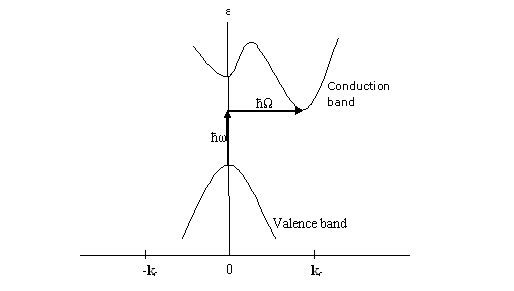indirect absorption
PHONONS FROM INDIRECT ABSORPTION
An indirect band gap is where the maximum of the valence band and the minimum of the conduction band occur at different values of k. The maximum of the valence band is at k = 0, but the minimum in the conduction band is at a k vector on the Brillouin zone boundary.

Figure 3: Indirect transitions involving a photon and a phonon since the band edges for of the conduction and valence bands are widely separated in k space.
In the indirect absorption process, the minimum energy gap of the band structure involves electrons and holes separated by a substantial wavevecktor kc. Since photon wavevectors are negligible at the energy range of interest, a direct photon transition at the energy of the minimum band gap does not satisfy the requirement of conservation of wavevector. But, if a phonon is created in the process, the conservation laws are satisfied, where
K(photon) = kc + k ≈ 0; ћω = Eg + ћΩ
The phonon energy, ћΩ generally is much less than Eg. At a high enough temperature, thermally excited phonons are already in the crystal, and so it is possible to have a photon absorption process where the phonon is absorbed.
The absorption spectrum of a semiconductor provides a direct method for measuring the energy gap. The band gap and the electron energies are temperature dependent; where thermal expansion changes the interatomic spacing and hence the lattice potential and also the electron energies are changed by the presence of thermally excited lattice vibrations. Optical measurements on the other hand determine whether the gap is direct or indirect.
editted by Wan Maryam Wan Ahmad Kamil
Reference
Solid state physics, J.R.Hook and H.E.Hall, second edition.
